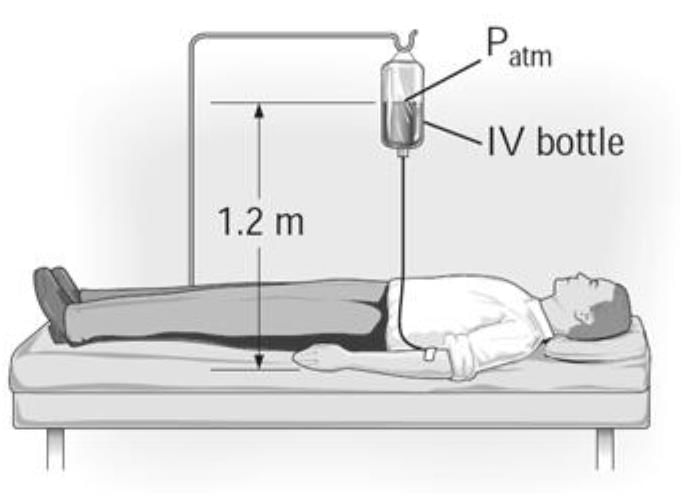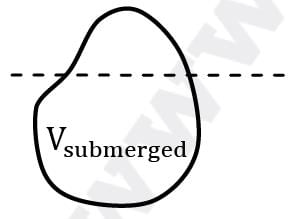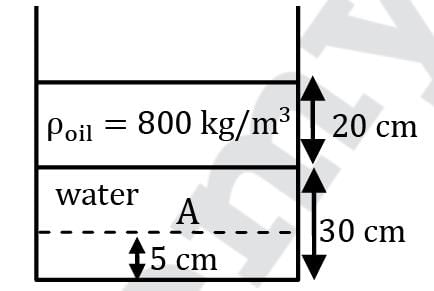Test: Pressure & Fluid Statics Level - 1 - Mechanical Engineering MCQ
20 Questions MCQ Test Fluid Mechanics for Mechanical Engineering - Test: Pressure & Fluid Statics Level - 1
A manometer is used to measure the pressure of a gas in a tank. The fluid used has a specific gravity of 0.85 and the manometer column height is 55 cm, as shown in figure. If the local atmospheric pressure is 96 kPa, what is the absolute pressure in the tank?


A crane is used to lower weight into the sea (sea water density = 1025 kg/m3) for an underwater construction project. What is the percentage reduction in the tension in the rope of the crane due to a rectangular 0.4 m × 0.4 m × 3 m concrete block (density = 2300 kg/m3) when it is completely immersed in water compared to the tension in the rope when it was suspended in air
Three immiscible liquids of specific densities, ρ, 2ρ and 3ρ are kept in a jar. The height of the liquids in the jar and in the piezometer fitted to the bottom of the jar is as shown in the given figure. The ratio H/h is


Pressure drop of water flowing through a pipe between two points is measured by using a vertical U-tube manometer. The manometer uses a liquid with density 2000 kg/m3 . The difference in height of manometric liquid in the two limbs of the manometer is observed to be 10 cm. The pressure drop between the two points is
The reading of pressure gauge (expressed in terms of meters of water) shown in the figure is

Which of the following statements is correct regarding the center of pressure for a planar solid surface submerged in an incompressible fluid?
A bucket partially filled with water is hanging from a spring balance. An iron piece is suspended into water without touching the sides of the bucket with help of another support. If no water is spilled out the spring balance reading will
A bucket completely filled with water is hanging from a spring balance. An iron piece is suspended into water without touching the sides of the bucket with help of another support. The spring balance reading will
A small plastic boat loaded with pieces of steel rods is floating in a bathtub. If the cargo is dumped into the water allowing the boat to float empty, the water level in the tub will
For the stability of a floating body, which of the following is true?
The average density of freshwater ice is about 917 kg/m3. Determine the percentage of the total volume of an iceberg submerged in seawater of density 1042 kg⁄m3.
Consider a container of circular cross-section (100 cm2). Initially 2 liters of oil (specific gravity 0.8) is poured in the container and then 3 liters of water is poured in it. Find out pressure, in Pa at a point 5 cm above the bottom surface of the container.
If the atmospheric pressure in Delhi is 74 cm of Hg and in Manali it is 60 cm of Hg, work out the elevation of Manali with respect to Delhi. (in meters). Consider the density of atmospheric air to be uniform and equal to 1.2 kg/m3.(Answer is Integer only)
Intravenous infusions are usually driven by gravity, by hanging the fluid bottle at sufficient height to counteract the blood pressure in the vein and to force the fluid into the body. The higher the bottle is raised, the higher the flow rate of the fluid will be. The density of the fluid is 1020 kg/m3.
If it is observed that the fluid and the blood pressures balance each other when the bottle is 1.2 m above the arm level, determine the gauge pressure of the blood in kPa.

The hull of a boat has a volume of 150 m3 and the total mass of the boat when empty is 8560 kg. Determine how much load this boat can carry without sinking in a lake (fresh water) and in sea (S = 1.03)?
A cylindrical body of cross-sectional area A, height H and density ρs is immersed to a depth h in a liquid of density ρ, and tied to the bottom with a string. The tension in the string is

If two objects are weighed in water and both of them lose the same weight, then the two objects must have identical
An inclined plate 2 m long and 1 m wide lies with its length inclined at 45° to the surface of water and its nearest edge is 1 m below it. If specific weight of water is 1000 kg/m3, then total pressure force on the plate (in kg) is approximately
An inclined plate 2 m long and 1 m wide lies with its length inclined at 45° to the surface of water and its nearest edge is 1 m below it. If the specific weight of water is 1000 kg/m3. Find out the depth of the centre of pressure for the submerged surface of the plate?
Which of the following statements regarding piezometer is incorrect?
|
56 videos|106 docs|75 tests
|

































